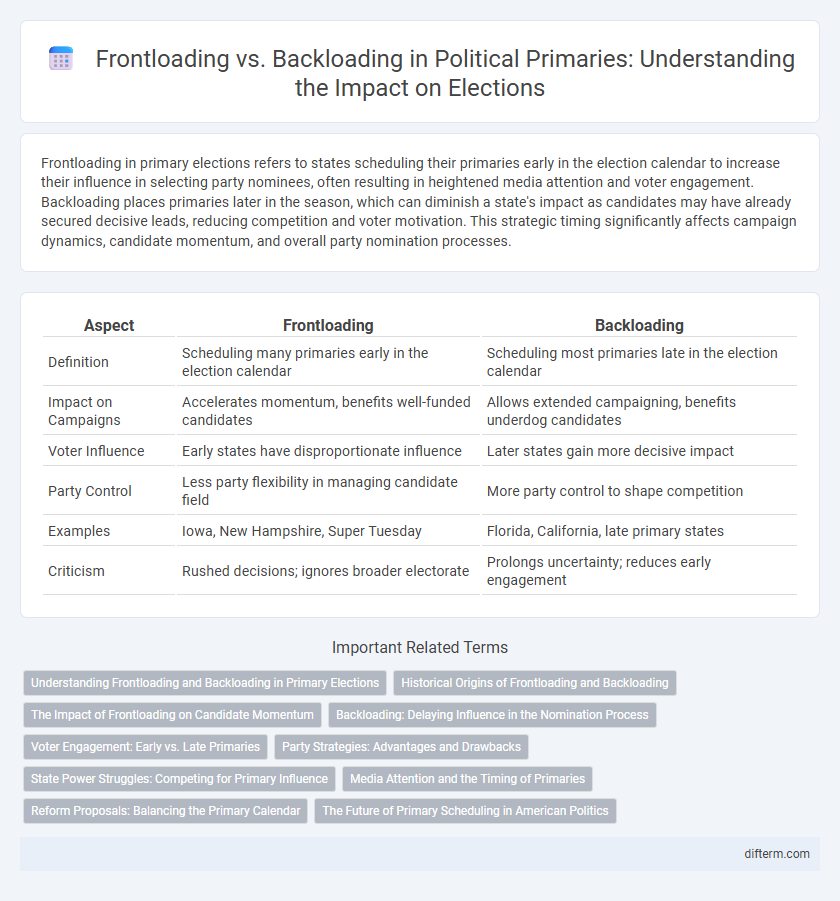Frontloading in primary elections refers to states scheduling their primaries early in the election calendar to increase their influence in selecting party nominees, often resulting in heightened media attention and voter engagement. Backloading places primaries later in the season, which can diminish a state's impact as candidates may have already secured decisive leads, reducing competition and voter motivation. This strategic timing significantly affects campaign dynamics, candidate momentum, and overall party nomination processes.
Table of Comparison
| Aspect | Frontloading | Backloading |
|---|---|---|
| Definition | Scheduling many primaries early in the election calendar | Scheduling most primaries late in the election calendar |
| Impact on Campaigns | Accelerates momentum, benefits well-funded candidates | Allows extended campaigning, benefits underdog candidates |
| Voter Influence | Early states have disproportionate influence | Later states gain more decisive impact |
| Party Control | Less party flexibility in managing candidate field | More party control to shape competition |
| Examples | Iowa, New Hampshire, Super Tuesday | Florida, California, late primary states |
| Criticism | Rushed decisions; ignores broader electorate | Prolongs uncertainty; reduces early engagement |
Understanding Frontloading and Backloading in Primary Elections
Frontloading in primary elections refers to the practice of scheduling state primaries and caucuses early in the election calendar to maximize influence over candidate selection. Backloading occurs when states hold their primaries later, often diluting their impact as the nomination is frequently decided by earlier contests. The timing of primaries significantly affects campaign strategies, voter engagement, and the overall momentum of presidential candidates.
Historical Origins of Frontloading and Backloading
The historical origins of frontloading in primaries trace back to the 1980s when states began moving their contests earlier to increase influence in the candidate selection process, notably after the 1980 reform of the Democratic Party's rules. Backloading emerged as a counter-strategy, with some states scheduling later primaries to benefit from a clearer field and greater media attention once front-runners were established. This dynamic created a primary calendar imbalance that has shaped modern presidential nomination strategies and delegate allocation.
The Impact of Frontloading on Candidate Momentum
Frontloading in primary elections accelerates the schedule, concentrating multiple state contests early in the season and creating intense media and voter scrutiny that can rapidly boost a candidate's momentum. Candidates who perform well in early frontloaded states gain increased fundraising opportunities and heightened national visibility, reinforcing their perceived electability. Conversely, early losses in frontloaded contests often stall campaigns before later states vote, reducing the chances for recovery and reshaping the competitive landscape.
Backloading: Delaying Influence in the Nomination Process
Backloading in primary elections refers to scheduling key state primaries later in the nomination calendar, which delays early influence on candidate momentum and allows frontrunners from early contests to solidify support. This strategy can increase voter information and reduce impulsive decisions by extending the nomination contest, often favoring well-funded candidates with sustained campaign resources. States utilize backloading to amplify their impact during later stages, potentially shifting negotiations and delegate allocations toward a more deliberate, consensus-driven conclusion to the nomination process.
Voter Engagement: Early vs. Late Primaries
Early primaries in frontloading boost voter engagement by creating momentum and media attention, encouraging higher turnout and candidate visibility. Late primaries in backloading can benefit from increased voter information and strategic decision-making as more data emerges from earlier contests. However, late primaries often experience decreased participation due to diminished influence on the overall nomination outcome.
Party Strategies: Advantages and Drawbacks
Frontloading primaries allows parties to capitalize on early momentum, shaping candidate narratives and influencing media coverage, but risks diminishing voter engagement in later states. Backloading spreads the electoral influence more evenly, giving lesser-known candidates more time to build support, though it may prolong uncertainty and reduce national media focus. Strategic decisions hinge on balancing visibility, voter turnout, and resource allocation to optimize delegate accumulation.
State Power Struggles: Competing for Primary Influence
State power struggles intensify during frontloading and backloading of primaries as early-voting states leverage frontloading to amplify their political influence and shape candidate momentum. Backloading allows later states to assert strategic control, often enabling shifts in delegate accumulation and campaign resource allocation. These competing timelines create a dynamic contest for primary influence, directly impacting candidate viability and party power balance.
Media Attention and the Timing of Primaries
Frontloading primaries concentrate media attention early in the election cycle, often shaping candidate momentum and voter perceptions by spotlighting frontrunners in initial contests. Conversely, backloading schedules allocate more primaries later, allowing a sustained media narrative that can shift with emerging candidate performances and changing voter sentiments. The timing of primaries thus profoundly influences the dynamics of campaign coverage and the strategic allocation of media resources.
Reform Proposals: Balancing the Primary Calendar
Reform proposals for balancing the primary calendar emphasize a hybrid approach combining frontloading and backloading to ensure equitable voter influence and candidate evaluation time. Advocates suggest regional primaries clustered by state size or political diversity to prevent front-loaded dominance while avoiding the prolonged uncertainty of backloading. Data-driven models recommend compressing the calendar to reduce campaign costs and enhance media coverage, promoting fairness and voter engagement across all states.
The Future of Primary Scheduling in American Politics
Frontloading, where states schedule primaries early to maximize influence, intensifies campaign pressures and may marginalize lesser-known candidates, while backloading delays key contests, potentially diminishing voter engagement and momentum for frontrunners. The future of primary scheduling in American politics likely involves a strategic balance to ensure both equitable voter representation and manageable campaign dynamics. Emerging proposals emphasize regional primaries or rotating windows to mitigate the drawbacks of frontloading and backloading, aiming to enhance democratic participation and candidate viability.
Frontloading vs Backloading (primaries) Infographic

 difterm.com
difterm.com